Why Civilization Would Collapse Even Without Climate Change

I want to start by emphasizing that I have nothing but love and respect for the millions of climate activists in the world, many of whom work tirelessly to end fossil fuels, even to the point of getting arrested. Organizations like Greenpeace, Extinction Rebellion, Fridays for Future, and countless others have done incredibly important work and deserve our thanks.
However, I’ve noticed that average, everyday climate activists often don’t see the big picture. They are laser-focused on climate change and believe that if we just stop burning fossil fuels and start using green energy, we can save the planet and our civilization.
The truth is that even if there were no climate change, our civilization would still be doomed. And the more time we waste trying to save it, the more damage we’ll do to the biosphere. It’s time to give up on the idea of saving modern, high-tech civilization and instead focus on saving as much of the natural world as possible.
For those who still believe we can continue with business-as-usual using green energy instead of fossil fuel energy, this article will be a wakeup call, and it could be very upsetting. I don’t want to upset people, but it’s important that we face reality so we can make better choices as we move forward.
Okay, take a deep breath, and let’s dive in…
Exponential Growth
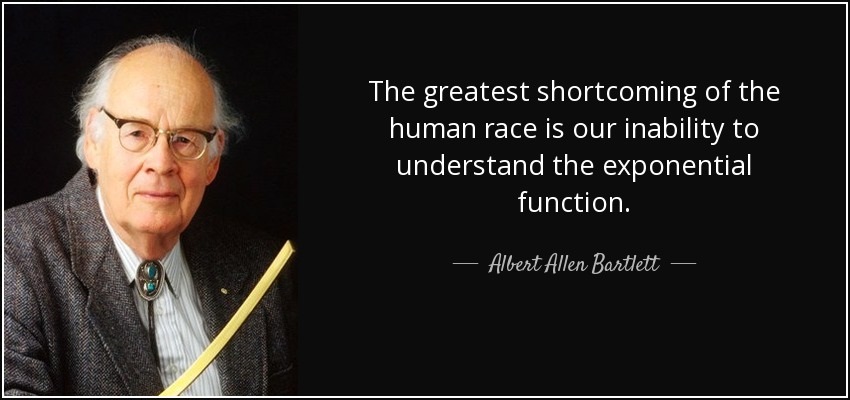
Before I explain the specific reasons why civilization is doomed no matter what we do, I think it would be worthwhile to review the concept of exponential growth. Most people think they understand it, and they might even give an accurate definition, but they’re not truly grasping the implications of exponential growth in a finite world.
Exponential growth is when something doubles at regular intervals. At first, it seems slow, then it gets faster, then suddenly it’s astronomical.
Here’s a useful analogy which I already wrote about in this post. Imagine you’re sitting in the top row of Wembley Stadium, a massive football stadium that can seat up to 90,000 people.
Beneath the field, a pipe in the sprinkler system begins to leak exponentially. In the first minute, it leaks 1 drop of water. In the second minute, it leaks 2 drops of water. In the third minute, it leaks 4 drops of water. And so forth, doubling every minute.
How long before the entire stadium fills up with water and you drown? Most people guess days or even weeks, but the answer is 44 minutes. (The math is explained in detail here.) But the scary part isn’t how quickly the stadium fills with water; it’s how quickly it goes from mostly empty to completely full.
After 15 minutes, there would only be one gallon of water on the field. Not enough to even notice. After 30 minutes, there would be a swimming pool’s worth of water, but spread across the field, it would only be enough to make the grass wet. After 44 minutes, the stadium would be completely full.
Think about that for a moment. The stadium goes from having a wet field to being completely full in just 14 minutes. And one minute later, there would be enough water to fill two stadiums.
Now consider the global economy. It has been doubling in size every 20-30 years for the past century. That means that under normal growth, the global economy would double again by 2050.
If you think the economy is just numbers in bank accounts, then this might seem doable. But the economy isn’t just numbers. It’s also material things like bricks, concrete, alloys, asphalt, plastic, glass, and so forth—all of which require vast amounts of energy to create.
Because we managed to double the world economy over the last 20 years, there are now twice as many of these material things as there were in the year 2000. In fact, human-made mass now exceeds all living biomass.
If the economy keeps growing exponentially, the amount of human-made mass will grow another threefold by 2040. However, given that we are running out of fossil fuels and pushing the biosphere to the limit, it’s safe to say that economic growth will come to a halt before then.
In our analogy, we’re at the point where the field is wet, and people are saying, “Sure, there’s a water leak, but we have plenty of time to fix it before the stadium is full.”
No, we don’t.
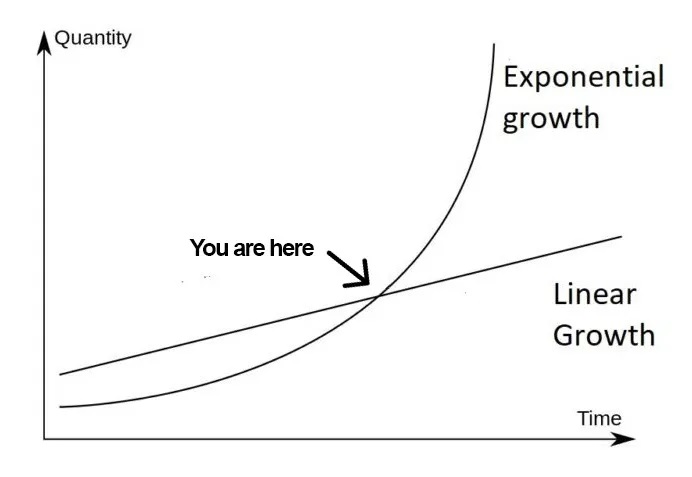
Overshoot
In order to understand why civilization is going to collapse, you need to understand a concept known as ecological overshoot. (I wrote about it in more detail in this post.)
Overshoot is when an organism exceeds the carrying capacity of its environment by drawing down resources faster than they can regenerate. Once a species is in overshoot, a population collapse is inevitable because eventually, there won’t be enough surplus resources left to sustain the population.
I realize that is kind of wordy definition, so let’s take a look at a real-world example.
The St. Matthew Island Reindeer Herd
St. Matthew Island is a small island off the coast of Alaska that was unoccupied until World War II. In 1941, the US military set up a LORAN station and put 19 soldiers on the island to operate it.
The Coast Guard released 29 reindeer onto the island as an emergency food source, but the soldiers never hunted them. After the war ended, the station was abandoned, and the reindeer stayed behind.
For the deer, it was paradise. There were no predators to worry about and more food than they could possibly eat. Grass grew everywhere, and thick layers of lichen coated the trees. Since the island was 128 square miles, it was hard to imagine how a small herd of reindeer could ever consume everything. But of course, they did.
In 1957, a biologist named David Klein visited the island. He and his assistant counted about 1,350 reindeer. They seemed well-fed, and there was still plenty of grass, lichen, and other plants for the deer to eat.
In 1963, Klein returned to the island with three other scientists. They counted about 6,000 reindeer. However, the deer didn’t seem as well-fed as before. Many of them were skinny, and the island showed signs of overgrazing.
In 1966, Klein returned to the island one more time, but what he found was horrifying. The island was littered with reindeer skeletons, and only 42 living reindeer remained. The population had crashed by 99% in just a few years.
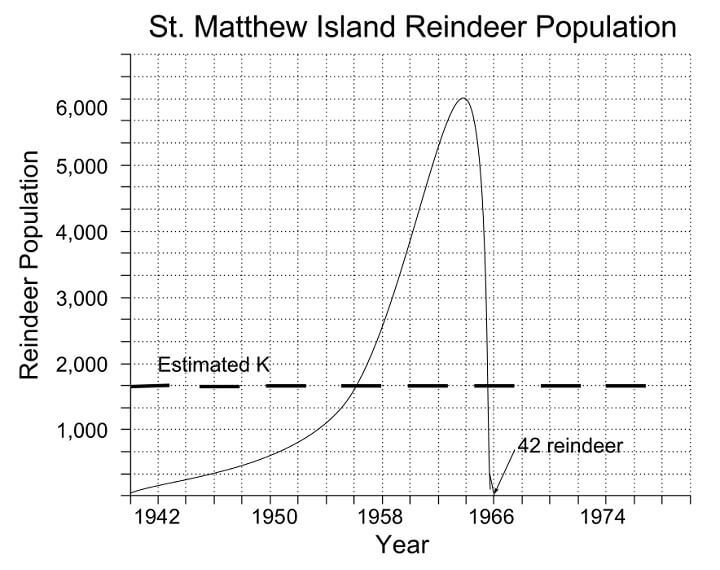
So why did the population plummet so rapidly? The answer is overshoot. It has been estimated that the carrying capacity of the island is about 1800 deer, but the deer were able to overshoot the carrying capacity by consuming plants and lichen that had accumulated long before they arrived.
By 1964, all the extra food was gone, and the island only produced enough flora to feed about 1800 deer, but that doesn’t mean 1800 deer remained well-fed while the rest had nothing. Rather, all of the deer had some food to eat, just not enough to live on. Thus, most of them starved to death slowly.
People think that since humans are far more intelligent than deer, we would never make the same mistake. Unfortunately, we’ve been making the same mistake for over half a century.
Earth Overshoot Day
Earth Overshoot Day marks the date when humans have used up all the resources that the Earth can generate in a year—resources like fish, forests, topsoil, aquifers, fossil fuels, and more.
This year, Earth Overshoot Day was on August 2nd. Since then, we’ve maintained growth by overexploiting fisheries, cutting down forests, using up years worth of topsoil, drawing down aquifers, and burning fossil fuels that took eons to accumulate.
According to the World Wildlife Fund, we have already been in overshoot for at least 50 years. Eventually, there won’t be enough surplus resources, and we’ll be forced to live on what the planet can generate each year.
It will be unpleasant, to put it mildly.
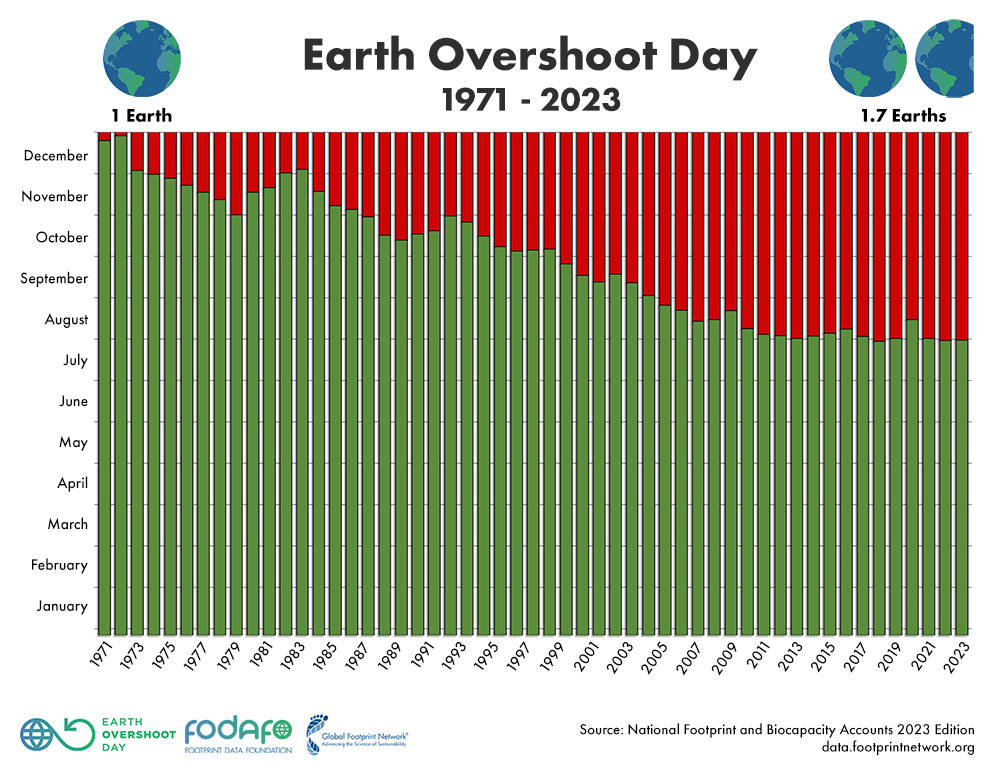
Limits to Growth
In 1970, the world was in the midst of the Great Acceleration, a time of economic growth unlike anything ever seen. Silent Spring had been published 8 years prior, helping to spark the environmental movement, and many people began to wonder just how large civilization could grow before running out of space and resources.
To answer that question, the Club of Rome commissioned a study performed by a group of 17 researchers at MIT. The main purpose was to determine the limits of the world system and the constraints it puts on human numbers and activity.
The researchers created a dynamic systems model called World3 that looked at five variables: population, food production, industrialization, pollution, and consumption of nonrenewable natural resources. Using a computer, they mapped out 12 scenarios for the future.
For example, what if we recycle everything? What if every couple only has two children? What if we somehow double our resources? And so forth.
One scenario, called the standard run, showed what would happen if humans don’t make any changes and continue with business as usual. Under that scenario, the global population would peak by 2030 and begin to decline.
In 1972, the team of researchers published their findings in a book called Limits to Growth and warned that without substantial changes in resource consumption, “the most probable result will be a rather sudden and uncontrollable decline in both population and industrial capacity”.
And remember, this model doesn’t account for climate change.
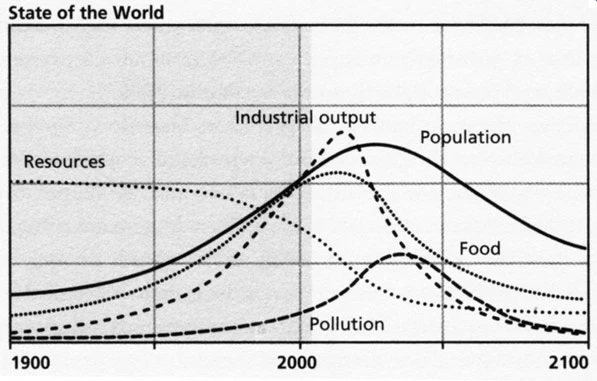
The book went on to sell 12 million copies, making it the best-selling ecology book of all time. However, it received a lot of criticism from economists and world leaders who didn’t like the idea that economic growth could ever stop. Critics attempted to poke holes in the study, but none of them could explain how infinite growth on a finite planet is possible.
Now that several decades have passed, we can look at historical data and compare it to the Limits to Growth scenarios, and that’s exactly what Dr. Graham Turner of the University of Melbourne did. He gathered data from the United Nations, the BP Statistical Review, and several other sources, and plotted it alongside the Limits to Growth scenarios.
He found that we are tracking the business-as-usual scenario more closely than any other scenario. Under this scenario, the global death rate would be begin to rise by 2020 (and it did, even before the pandemic), and that the global population would begin to decline by 2030.
Turner isn’t the only researcher to compare historical data to the Limits to Growth scenarios. More recently, Gaya Herrington, a graduate of Harvard, did the same thing as part of her thesis for a Master’s in Sustainability. As she said, “Given the unappealing prospect of societal collapse, I decided to conduct a quantitative comparison between World3 scenarios and empirical data available in 2019.”
She compared the data to four scenarios and found that while we’re following the BAU (business-as-usual) scenario closely, we’re following the BAU2 scenario (where we continue business-as-usual with double the resources) even more closely.
This means humans have managed to find more resources than expected. However, under this scenario, collapse happens around the same time, only it happens because of pollution and ecosystem breakdown before natural resources run out.
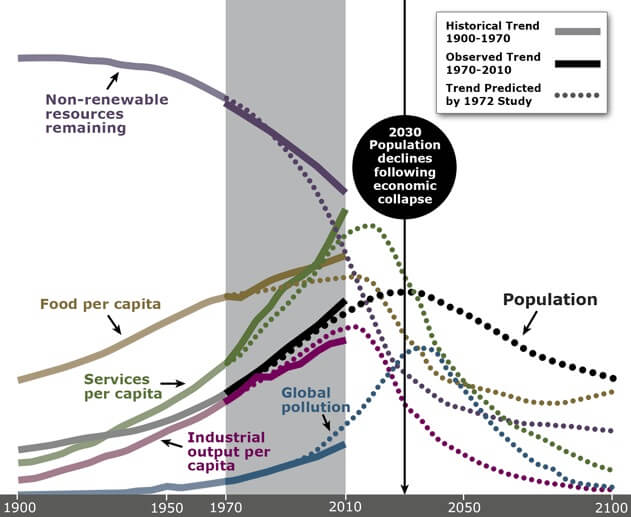
GRO
World3 isn’t the only computer model predicting societal collapse by 2040. In 2015, a team at Anglia Ruskin University’s Global Sustainability Institute developed a much more sophisticated computer model.
This model had about 2,000 parameters along with a massive database of statistics from 1995 to 2012, making it far more accurate. The project was called the Global Resource Observatory (GRO) project, and you can read about the results here.
Dr. Aled Jones, Director of the Global Sustainability Institute, said, “We ran the model forward to the year 2040, along a business-as-usual trajectory based on ‘do-nothing’ trends — that is, without any feedback loops that would change the underlying trend.
“The results show that based on plausible climate trends, and a total failure to change course, the global food supply system would face catastrophic losses, and an unprecedented epidemic of food riots. In this scenario, global society essentially collapses as food production falls permanently short of consumption.”
Although these computer models are sophisticated and based on real data, they are still theoretical. Where is the actual evidence that civilization is going to collapse?
Dwindling Resources
As explained above, a species goes into overshoot by using up natural resources that accumulated long before the species even existed. Overshoot is always followed by collapse once the extra resources are gone. Here’s a helpful analogy.
Imagine a man earning $100,000 a year who inherits $1 million from his uncle. Instead of investing the money, he decides to spend it, but he only spends about $100,000 per year. Now he is living on $200,000 a year, so he gets a nice apartment, leases a new car, and buys all sorts of expensive things.
After a few years, he starts to worry about what will happen when the inheritance is gone. But he tells himself, “It’ll be fine. Eventually, I’ll get promoted and get a huge raise.” So he continues living on $200,000 a year.
After ten years, all the money he inherited is gone, and he hasn’t gotten a raise. In order to maintain his comfortable lifestyle, he starts going into debt, telling himself he’ll find a way to pay it back later.
Eventually, he’s forced to sell all of his things, and he’s kicked out of his apartment. He still has his debt, so now he’s even worse off than he was before the inheritance.
Humanity is doing something similar on a global scale. We inherited all sorts of natural resources—fish, forests, topsoil, aquifers, fossil fuels, and much more—but we’re using them up faster than they can regenerate.
So how long until these resources are gone? Before I answer that, I need to clear up a misconception. It’s unlikely that these resources will ever be completely gone—at least not this century. Civilization will collapse long before the last fish is caught or the last tree is cut down.
Although there will always be some resources, the problem is that there won’t be enough for everyone.
Remember the St. Matthew Island reindeer herd? As I explained, the island continued generating enough food for about 1800 reindeer every year, but because there were 6000 reindeer, nearly all of them died. It didn’t matter that there was still some food. None of them had enough.
Keep that in mind as we look at some specific natural resources we’re overexploiting.
Fisheries
About 3 billion people rely on wild-caught fish as part of their daily diet, and at least 10% of the world population relies on income from fish and other seafood products, making fisheries a crucial part of the global economy.
Unfortunately, we are catching fish faster than they can replenish themselves, and the problem has slowly gotten worse over the past few decades. Already, about half of the world’s fish stocks are overfished, and 10% are on the verge of total collapse.
In the UK, half of the fishing industry’s key stocks are overfished, which is part of the reason cod are disappearing. In the Bering Sea, billions of snow crabs have vanished. And in Bangladesh, nearly all fish species are being pushed to the brink.
This is just a small sampling of what’s going on. And on top of all that, demand for fish is expected to double by 2050. This is unsustainable.
Many countries have laws against overfishing, but that’s not stopping the fishermen. Currently, about 20-32% of wild-caught seafood in the US is illegal and unreported. And sometimes, the overfishing isn’t even illegal. It happens because of loopholes in the law.
Of course, overfishing isn’t the only thing killing off marine species. Pesticides are also part of the problem. Several studies have linked neonicotinoids, a key ingredient in some pesticides, to die-offs in many fish species.
Another thing killing fish is plastic pollution. Microplastics have been found throughout the ocean, even at the bottom of the Mariana Trench. It’s gotten so bad that the oceans are literally emitting microplastics into the atmosphere.
Microplastics are a problem because they often have toxic chemicals attached to them, so when fish consume them day after day, they have reproductive problems and often get sick and die. Microplastics also kill plankton, an important source of food for many fish.
According to a report from the World Wildlife Fund, 88% of fish have already been adversely affected by microplastics. Given that the microplastic crisis is getting worse exponentially, the consequences are going to be horrific. At this rate, the plastic in the ocean will outweigh all the fish in the ocean by 2050.
At some point in the coming years, the demand for fish will far outstrip the supply, making it too expensive for most people. This will cause a major food crisis in countries that depend on fish.
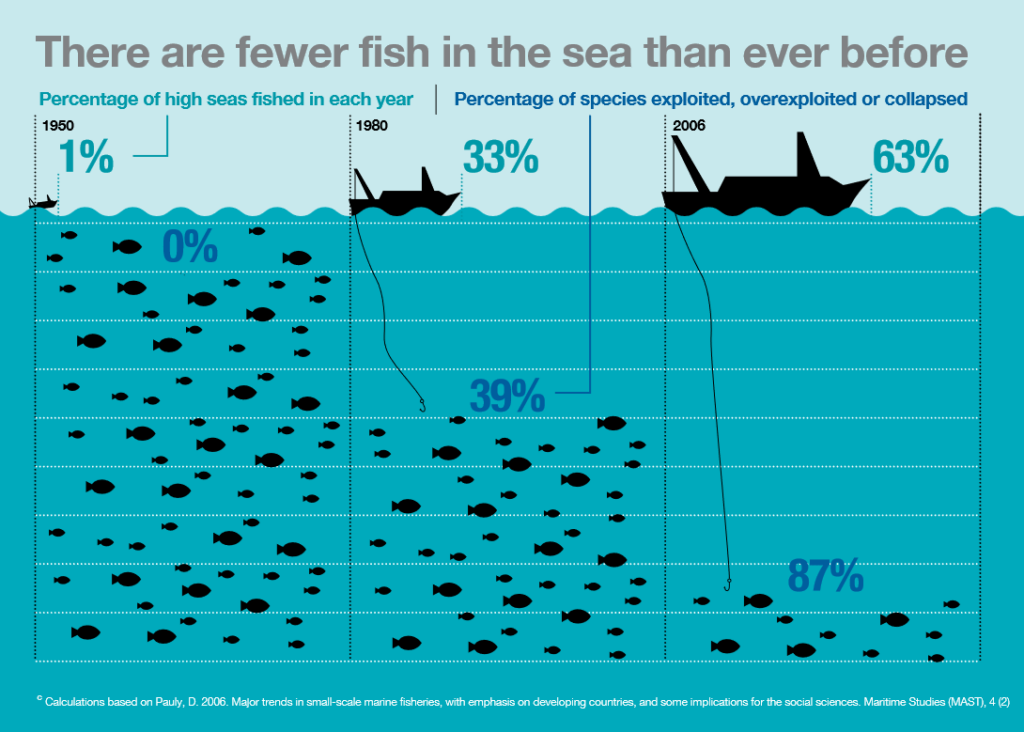
Forests
Most people don’t appreciate what trees do for us. They provide clean air, protect the soil, regulate the water cycle, and support natural and human food systems. In fact, half the world’s plants and animals rely on trees for survival. Without trees, we wouldn’t even be here.
This is why scientists are warning that if we don’t prevent tree extinctions, we’ll face a global ecological catastrophe. As explained by Malin Rivers, head of conservation prioritization at Botanic Gardens Conservation International, “Trees are essential … it’s like a Jenga tower. Pull the wrong one out and the ecosystem falls apart.”
And yet, we’re chopping them down at an unsustainable rate. Every year, over 15 billion trees are cut down for timber harvesting, urban expansion, cattle grazing land, and farms that produce soybeans and palm oil. In Europe, they’re actually burning trees and calling it “green energy.”
Meanwhile, less than 2 billion trees are planted per year. We can’t keep this up forever. Already, at least 30% of the world’s wild tree species are threatened with extinction, and thanks to worsening droughts, millions of trees are dying every year.
Some scientists have calculated that based on current rates of deforestation, civilization has about a 10% chance of making it through the next 20 to 40 years.
Topsoil
Many people—especially urbanites—believe that all you need to grow food is dirt and water. The truth is, nothing will grow in plain dirt. Instead, you need topsoil. Unlike dirt, topsoil is filled with fungi, bacteria, and tiny bugs and plants, all of which work together to create healthy soil in which we grow 95% of our food.
As Paul Harvey once said, “Man—despite his artistic pretensions, his sophistication, and his many accomplishments—owes his existence to a six-inch layer of topsoil and the fact that it rains.”
Sadly, we are using up our topsoil at an unsustainable rate. A single inch of topsoil can take up to 500 years to form, yet most farmers go through an inch of topsoil in just a few years. Some scientists estimate that we’re losing our topsoil about 10 to 40 times faster than it can regenerate.
As a result, about 30% of the world’s arable land has already become unproductive. Meanwhile. the land that is still productive is producing less nutritious food. Why? Because when you grow food in the same soil over and over, there are fewer minerals every season. This leads to slow-moving health problems in people who rely on these foods.
Society will probably collapse long before the use up every last bit of topsoil. The problem is that we’re nearing a point where there simply isn’t enough to go around.
Aquifers
Most people don’t realize this, but if not for aquifers, we would already be in a global famine. The only reason we still have farms in the Midwestern U.S. is because farmers pump groundwater out of aquifers and use it to irrigate their crops. The same thing is happening in drought-stricken California. In fact, 90% of water from aquifers is used for irrigating crops.
Unfortunately, we are using up groundwater like there’s no tomorrow. If we continue like this, many of the aquifers we rely on will be depleted in a matter of decades. There has been a lot of researching confirming this.
One study found that Europe’s aquifers are losing 84 gigatons of water (the equivalent of all the water in Lake Ontario) every year. Another study found that millions of wells around the world are going to dry up in the near future. In fact, 20% of the world’s groundwater wells are facing imminent failure, which would mean no drinking water for hundreds of millions of people.
As with most overshoot-related problems, water scarcity will get exponentially worse. More and more wells will go dry until food and water shortages become a global disaster.
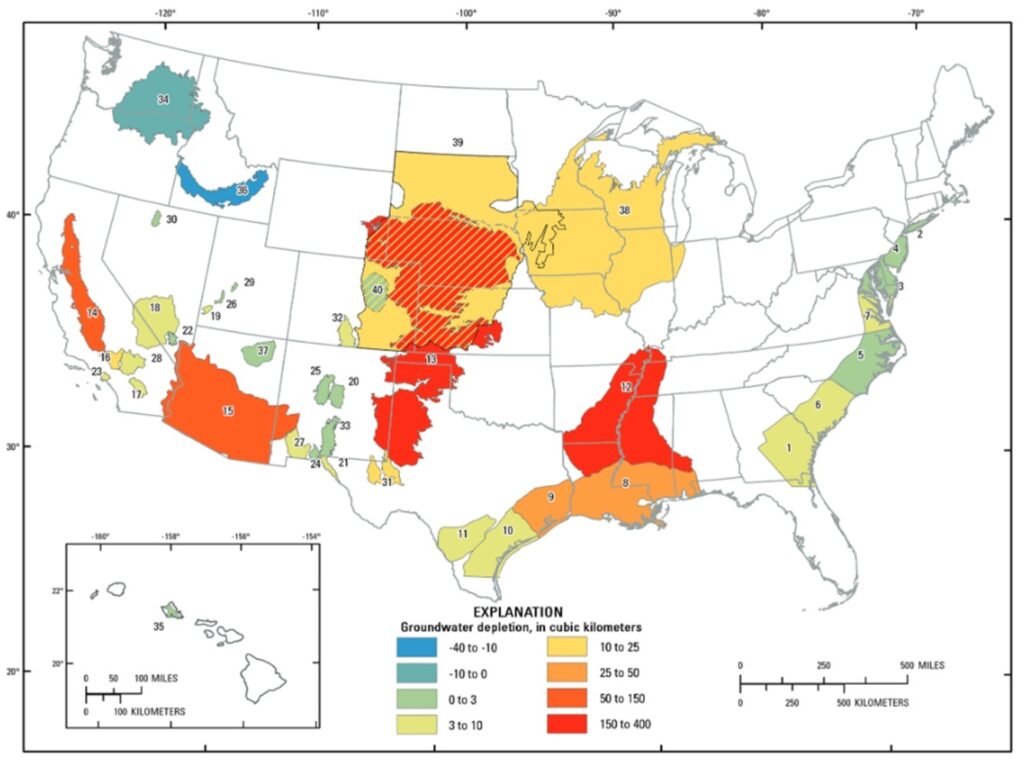
Fossil Fuels
As terrible as the decline of these natural resources is, the more immediate danger to modern civilization is the decline of fossil fuels.
To help you understand just how important fossil fuels are, try to imagine how many human slaves you would need to maintain your current lifestyle without fossil fuels. You’d need slaves to push your car to and from work; to manually turn generators that power your home; to create all the items you use or consume on a daily basis; to grow, harvest, and prepare your food.
Today, the average American uses the energy equivalent of approximately 500 slaves working 24 hours a day. When you look at it that way, you can see how crucial fossil fuels are to modern lifestyles. Without them, we would return to horse-and-buggy times, only without the basic skills and abundant natural resources people had back then.
As civilization gets more complex with new jobs and new inventions, it needs more energy to sustain itself. Once all the cheap energy is gone, complexity will collapse and we will go through what Nate Hagens calls The Great Simplification.
So how much longer before we start running out of fossil fuels?
It depends on which type you’re talking about. There are three main types of fossil fuels: coal, oil, and natural gas. There is still a lot of coal remaining, but oil and natural gas are far more important, and they will be gone in a matter of decades. Let’s start by talking about oil.
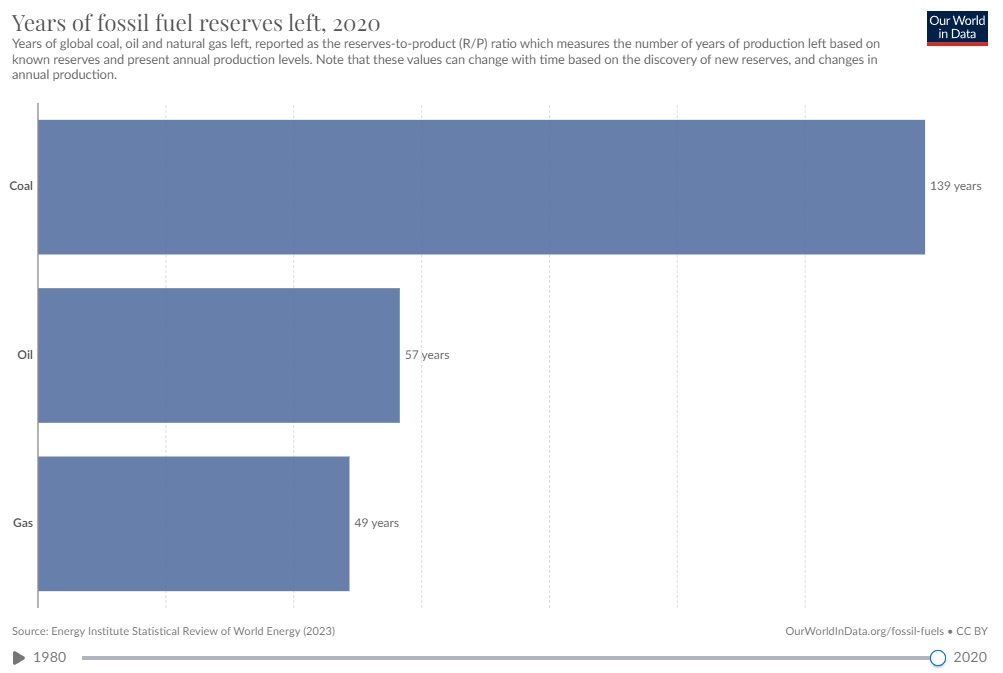
Peak Oil
Peak oil is when an oil field reaches maximum productivity before going into terminal decline. Once a field reaches peak oil, production will decline no matter how many oil rigs you add because the remaining oil is deeper and harder to extract. The concept of peak oil also applies to countries and to the world at large.
The term was coined by a geophysicist named Marion Hubbert. He noticed that when a country’s discovery of oil peaks, its production of oil peaks about 30-40 years later. Since U.S. oil discoveries peaked in the 1930s, Hubbert predicted that U.S. oil production would peak by 1970, and it did.
The subsequent oil shock caused gas prices to skyrocket and sent the U.S. into a period of stagflation. Because of this, many people began to wonder when the world would run out of oil, especially since global oil discoveries peaked in the late 1960s.
If Hubbert was correct, then the world would reach peak oil in the 2000s, and it did. According to the International Energy Agency, the world reached the peak of conventional crude oil in 2006.
Over the next few years, the price of oil went up to over $140 a barrel. The higher price of oil, along with improvements in fracking technology, made it economical for oil companies to start extracting shale oil, a type of unconventional oil found in shale rock formations. This led to a boom in oil production in the U.S. and many other countries.
However, it looks as though the U.S. shale revolution is nearly over. In fact, most of the shale oil fields are already in decline, and the largest one, known as the Permian basin, will probably peak in late 2024. Once the shale oil is gone, that’s it. There won’t be anymore unconventional sources of oil to swoop in and save the day.
The higher cost of oil will probably lead to a financial crisis. Of course, central banks will just create more money, but without abundant energy from oil, the economy won’t be able to grow in real terms, so everyone’s standard of living will continue to decline now matter how much their wages increase.
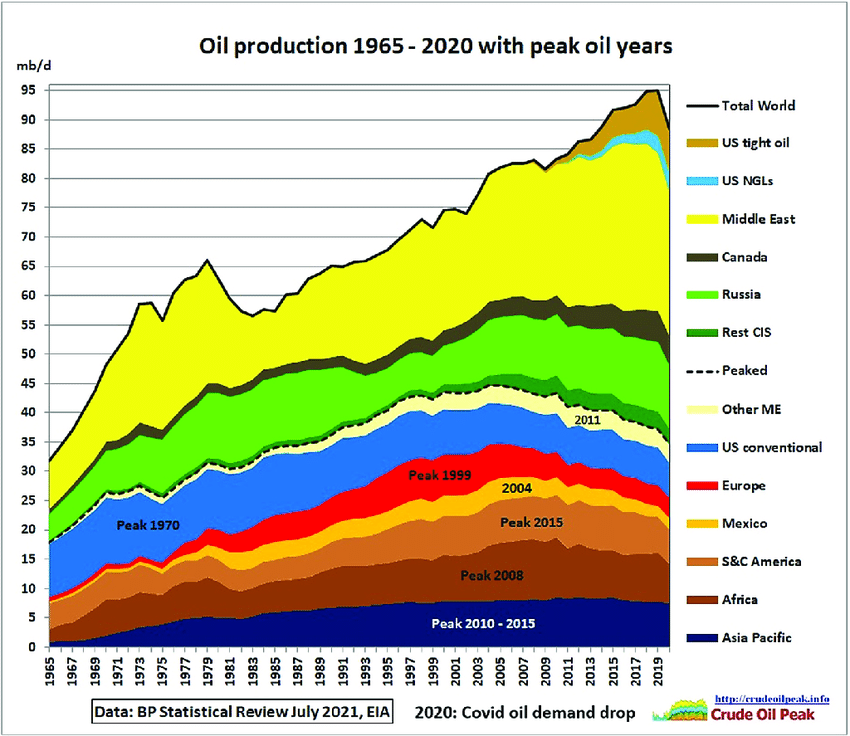
EROI
To be clear, there is still lots of oil in the ground. The problem is that the remaining oil is deeper and therefore more expensive to extract.
In the early 1900s, you could use the energy in 1 barrel of oil to extract 100 more barrels of oil, for an EROI (energy return on investment) of 100 to 1. It’s no wonder the economy started growing so rapidly back then.
Today, the EROI of oil is somewhere between 4 and 30, depending on the location and type of oil, and it continues to decline as we use up all the easy-to-reach oil. To keep the economy going, we’ll have to use more energy to extract oil, which means we’ll have less energy for other things.
As you can see in the graph below, our net-energy will begin to decline rapidly in about a decade. By 2050, half of our energy will go toward producing more energy, and the available oil for consumption on the market will be back down to where it was in the late 1960s.
It’s hard to imagine what this will look like since there are now over twice as many people in the world, and since oil is used to make thousands of everyday items. As explained in this paper, “Oil is a critical supply chain component for 90% of all industrially manufactured products; as such, it is the backbone of industrial civilization.” [emphasis mine]
Once the amount of oil available for consumption on the market declines, industrial civilization will begin to break down.
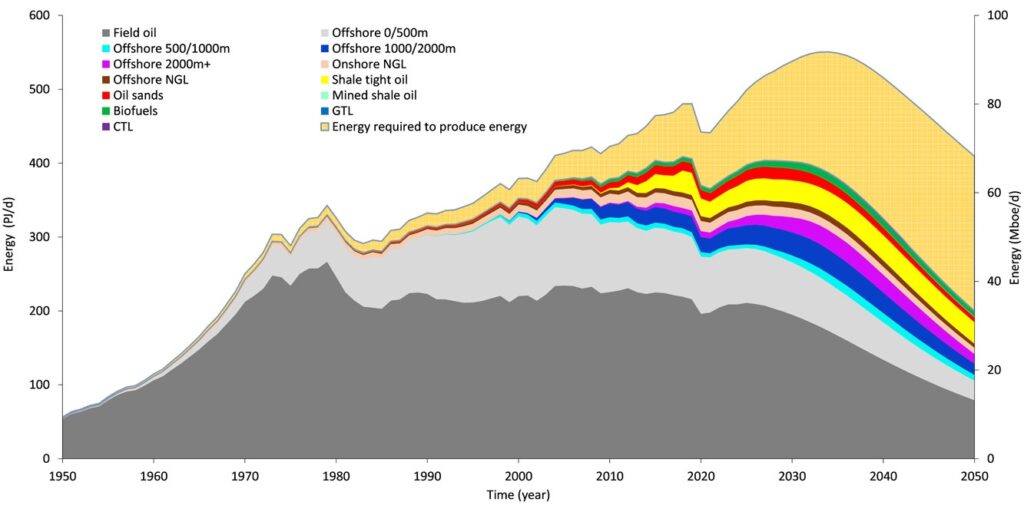
Natural Gas
Of course, oil isn’t our only source of energy. There’s also natural gas, but we’re running out of that, too. Estimates vary, but most experts believe we have about 50 years of natural gas left at current consumption rates. If economic growth continues, we only have 40 years left.
However, as oil becomes more scarce, natural gas will become more important. In fact, it’s already having a major effect on geopolitics. In 2012, about 2 trillion cubic meters of natural gas were discovered around the Crimean peninsula. Two years later, Russia annexed Crimea.
Natural gas is also part of the reason Russia invaded Ukraine. Advances in fracking technology unlocked vast reserves of natural gas in Eastern and Western Ukraine, giving it the potential to become Europe’s second petrostate.
Since Russia’s government depends on its oil and natural gas reserves, it didn’t like the idea of a direct competitor right next door. And since Ukraine was once part of the USSR, Putin decided to try and take it back, along with its natural gas. Of course, there are many other reasons Russia invaded Ukraine, such as the eastward expansion of NATO, but natural gas was certainly a major part of the decision-making process.
The decline of natural gas reserves will bring our civilization to its knees in the coming decades, and one of the main reasons has to do with fertilizer. Thanks to the Haber–Bosch process, we’re able to use natural gas to produce large amounts of ammonia, which is used to create synthetic fertilizer.
Why does this matter? Because literally half of the global population is supported by synthetic nitrogen fertilizer. Without natural gas, crop yields would be cut in half. As natural gas becomes more expensive, fertilizer will become more expensive, and food will become more expensive.
Eventually, a huge portion of the global population will be priced out of food, and chaos will ensue.
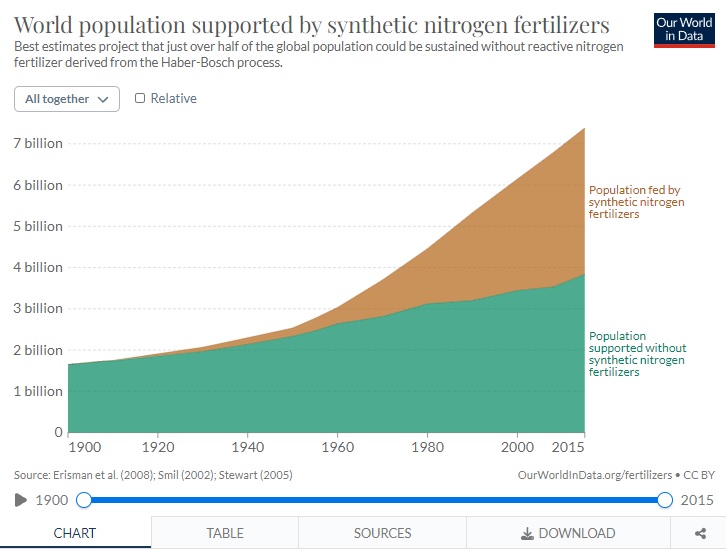
What About Renewables?
For years, the mainstream media has assured us that we are going to transition to renewables, which will solve our energy problems.
This is a pipe dream. Renewables mainly produce electricity, and electricity only accounts for about 20% of our global energy usage. Granted, more sectors could be electrified, but the main problem is that we need fossil fuels to create renewables.
For example, to create solar panels and wind turbines, we need plastic, steel, and cement, all three of which are made using fossil fuels. Affordable plastic can’t be made without oil, and steel and cement can’t be made at scale without fossil-fuel powered furnaces.
It gets worse. To build renewables—and all electronics, for that matter—we need rare-earth metals. Lots of them. Unfortunately, we’ve already mined all the easy-to-reach metals.
Take copper, for example, which is widely used in homes and electronics thanks to its unique properties. There was a time when miners would find giant nuggets of pure copper.
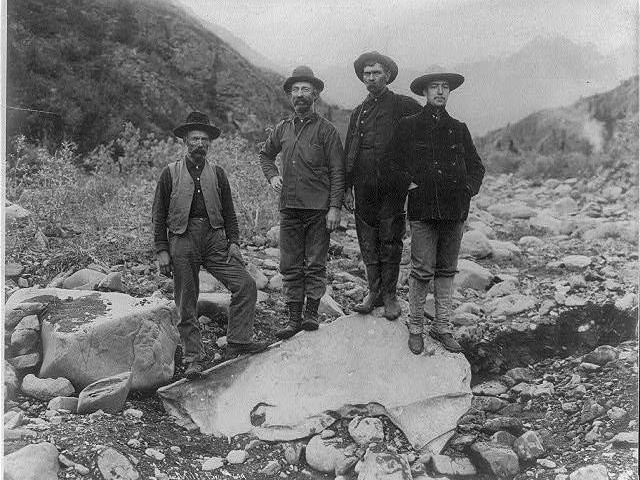
Today, most rocks mined for copper are actually less than 1% copper. That means we have to crush about 14 tons of rock just to get enough copper for one single-family home.
This problem is only going to get worse, and over time we’ll need more and more energy to extract the same amount of copper—and all other metals, for that matter. Some of the most crucial metals needed for electronics and green energy—such as cobalt and graphite—are already on the Department of Energy’s critical materials list.
To get these metals, not only do we have to crush giant rocks, we have to dig mines deeper and deeper into the ground. To do all this, we need diesel-powered machinery such as bulldozers, excavators, and dump trucks.
So far, we have never mined for metals without using fossil fuels. As professor Simon Micheaux once said, “We’re not mining with solar panels and wind turbines… and when we do, shit’s gonna get real.”
Once the rare-earth metals are mined, they have to be transported long distances (by diesel-powered trucks and ships) to factories where the ore is ground up and processed. After that, the metals are refined and smelted inside giant furnaces. None of this is done with green energy.
Even if we didn’t need fossil fuels to create renewables, there probably aren’t enough metals for a green energy revolution, anyway. For years, the mining industry has been warning that the energy transition isn’t sustainable. And now, the global supply for battery metals is running tight. After years of declines, green energy is getting more expensive.
Some argue that there are enough metals for a green energy revolution and that we just have to find them. I’ve looked at both sides of this debate, and I don’t know enough about geometallurgy to determine which side is correct.
Maybe there are enough metals. In fact, I’m sure there are if we dig deep enough. The problem is that doing so will require massive amounts of energy, and the only way to produce that much energy is with fossil fuels—which we’re running out of.
As Kevin Anderson explains in this article, “A fast transition [to renewables] requires increased energy usage over the short term. And, in the early stages at least, most of that energy will have to come from fossil fuels, because those are the energy sources we currently have.”
But as I’ve already pointed out, the amount of oil and natural gas available to the public will be cut in half over the next 30 years. How are we supposed to feed a growing population and completely rebuild the entire planet’s energy infrastructure with fewer and fewer fossil fuels? Just look at how far we have to go.
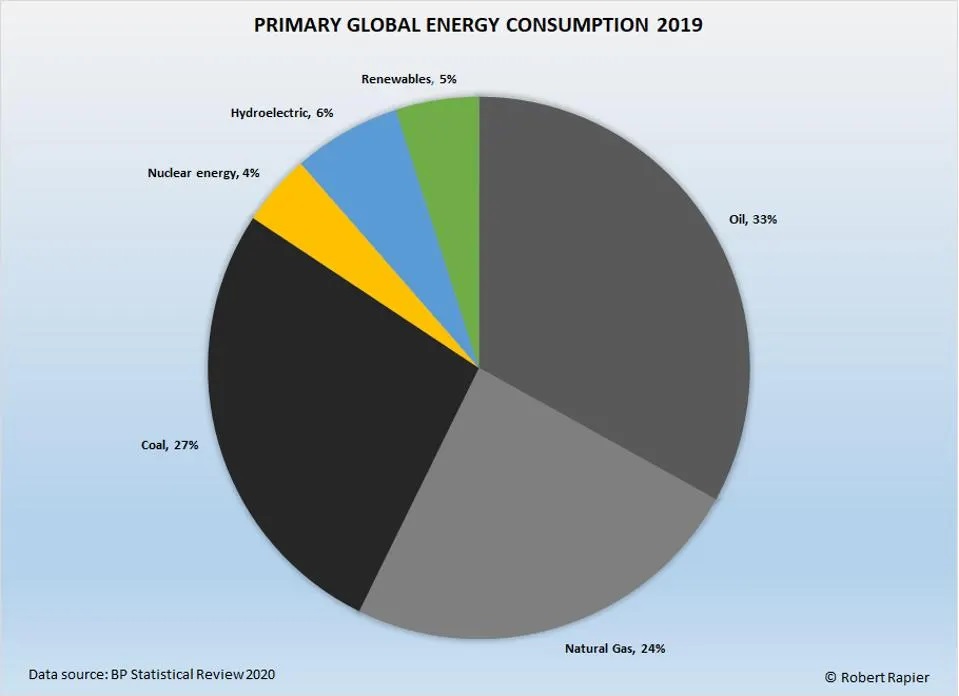
Today, the transport sector accounts for 30% of global energy usage. In order to get off of fossil fuels, every car, truck, and boat needs to be replaced with an electric version. But currently, electric vehicle sales only represent about 1 in 7 new car sales, and make up less than 3% of all vehicles globally.
That means 97% of drivers still own gas-powered vehicles. How are they all going to afford an electric vehicle? Even if the price of EVs comes down (which seems unlikely given supply constraints), people aren’t going to buy them if there aren’t plenty of charging stations around the world.
The same goes for construction companies. Even if they could all afford to replace their diesel-powered equipment with electric-powered equipment, they won’t be able to power them without adequate charging infrastructure.
The agricultural industry has a similar problem. The machines that till the land, spread fertilizer, and harvest plants run on diesel power because farms are spread out across vast, remote locations. There is no way to electrify all this at scale. And as for the airline industry, the batteries would make the planes too heavy to take off.
Even if it were possible to electrify everything, then not only do all of the world’s power grids need to run on green energy, and not only do they need to keep cooling our homes in a warming world, they also need to replace all the power supplied by diesel and gasoline. This simply isn’t doable with the limited time and resources available.
If you disagree and think that we could replace all the fossil fuel-based power stations of the world with wind and solar, you also have to solve the problem of intermittency. Since the sun doesn’t always shine and the wind doesn’t always blow, we need huge backup battery systems on a scale that is almost unimaginable.
Even if it could be done, let’s not forget that mining for metals is terrible for local ecosystems and biodiversity. If we actually mined enough metals to replace all fossil fuels, the damage to biodiversity could surpass those averted by climate change mitigation.
And of course, we would continue using up all the fish, forests, topsoil, and so forth. Is it really worth having a “green” economy if we end up destroying the planet, anyway? As professor Tom Murphy wrote, “If energy became essentially unlimited by some technology, I shudder to think what it would mean for the rest of the planet.”
But let’s set all of that aside for a moment. Most people assume that as we produce more green energy, it will replace fossil fuel energy, but that simply isn’t true. When more energy is added to the market, the price of energy goes down. In response, people consume more energy.
This is called Jevons Paradox, and it’s the reason fossil fuel consumption continues to rise in spite of the rapid increase in green energy. We’re not replacing fossil fuels with renewables; we’re just adding renewables to the pile.
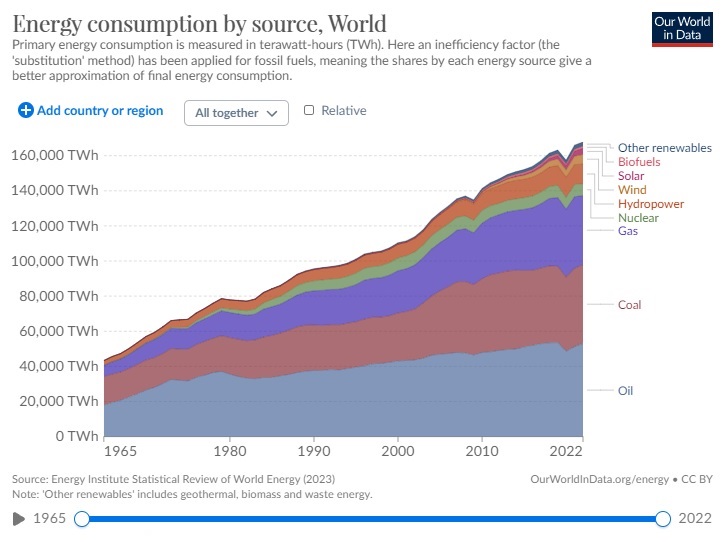
Conclusion
The only way to stop people from consuming more fossil fuels is for the government to forcibly phase them out and leave them in the ground. Considering that most governments are essentially owned by Big Oil, this seems unlikely.
Even if money in politics was banned in every country, no president is going to pursue a policy that would crash the economy and get them kicked out of office. And even if several countries collectively decided to stop using fossil fuels, other countries such as China would buy those fossil fuels instead. It’s the tragedy of the commons on a global scale.
Sadly, we probably won’t stop using fossil fuels until they’re too expensive to extract.
Some people will read this and call me a shill for the fossil fuel industry. The truth is, I loathe the fossil fuel industry. They knew about the dangers of climate change decades ago and chose to lie, putting short-term profits above the lives of billions of people.
While it’s true that civilization will collapse whether we stop climate change or not, climate activism is not a waste of time. The fewer fossil fuels we burn, the less we change the climate, the less damage we do to the biosphere, and the less suffering we cause.
However, we should also face the reality that climate change is rapidly accelerating and could trigger societal collapse even before we run out of natural resources. I’m currently working on an article about this very topic. Until next time.





Member discussion